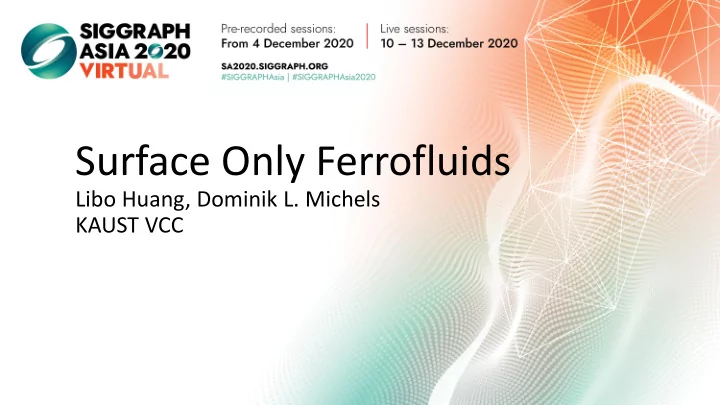

Surface Only Ferrofluids Libo Huang, Dominik L. Michels KAUST VCC
Overview • Introduction (10%) • Related Ferrofluid Simulation (10%) • Surface Only Liquids (20%) • Make It Magnetic! (30%) • Results (25%) • Conclusion (5%)
Introduction: What? • Ferrofluid: magnetic fluid • Spikes: minima of • Surface tension • Gravity energy • Magnetic energy
Introduction: How? • How to solve magnetic • How to apply magnetic fields? forces?
Related Ferrofluid Simulation • Huang et al. 2019 • Ni et al. 2020 Radial basis functions Cartesian grids Inter-particle forces Pressure boundary condition Surface tension? Extra air DOF?
Surface Only Liquids • Origin: Da et al. 2016 “Surface - only Liquids” • Key assumptions: curl-free and divergence-free
Surface Only Liquids • Origin: Da et al. 2016 “Surface - only Liquids” • Key assumptions: curl-free and divergence-free
Surface Only Liquids • Key assumptions: curl-free and divergence free • The interior velocity is uniquely defined by the boundary velocity.
Surface Only Liquids • Main steps: 1. Move boundaries to new positions 2. Make new velocity fields harmonic (curl-free and div-free) 3. Add forces as harmonic vector fields.
Make It Magnetic! • Basis: add forces as gradient of harmonic function • Example: gravity (top pressure=0), constant gradient solve boundary value problem->
Make It Magnetic! • Still gravity, but in a real simulation:
Make It Magnetic! • Gravity energy = negative integral of gravity body forces 𝑔 𝑠𝑏𝑤𝑗𝑢𝑧 = 𝜍
Make It Magnetic! • Surface tension energy = negative integral of surface forces 𝑔 𝑇𝑣𝑠𝑔𝑏𝑑𝑓 = 𝜏𝐼
Make It Magnetic! • Magnetic energy = negative integral of magnetic body + surface forces
Make It Magnetic! • 𝐹 = 𝐹 𝑇𝑣𝑠𝑔𝑏𝑑𝑓 + 𝐹 𝐻𝑠𝑏𝑤𝑗𝑢𝑧 + 𝐹 𝑁𝑏𝑜𝑓𝑢𝑗𝑑
Make It Magnetic! Put it all together: 1. Solve the magnetic field (BEM) 2. Get magnetic energy on surface 3. Add gravity, surface tension 4. Solve the gradient with BEM 5. Add the gradient to the velocity
Results
Results
Results
Results Surface Tension Field Strength
Results
Results
Results
Conclusion • Incorporate magnetic effects by adding magnetic energy on the surface using BEM • Benefits: • Less unknowns • Accurate surface tension • Drawbacks: • Limited to linear material • Complex boundary handling KAUST Computational Sciences Group • Difficult implementation
Recommend
More recommend